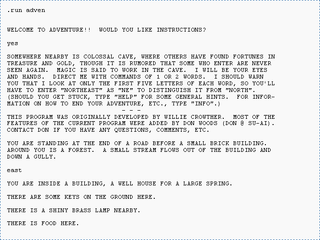
Colossal Cave Adventure is a text-based adventure game, released in 1976 by developer Will Crowther for the PDP-10 mainframe computer. It was expanded upon in 1977 by Don Woods. In the game, the player explores a cave system rumored to be filled with treasure and gold. The game is composed of dozens of locations, and the player moves between these locations and interacts with objects in them by typing one- or two-word commands which are interpreted by the game's natural language input system. The program acts as a narrator, describing the player's location and the results of the player's attempted actions. It is the first well-known example of interactive fiction, as well as the first well-known adventure game, for which it was also the namesake.

Landstalker: The Treasures of King Nole is an action-adventure game that was developed by Climax Entertainment and released for the Sega Genesis in 1992 in Japan and 1993 elsewhere. Players take on the role of the treasure hunter Nigel as he navigates a three-dimensional world through an isometric viewpoint, solving puzzles and fighting enemies.

Hillsfar is a role-playing video game for MS-DOS compatible operating systems, Amiga, Atari ST, and Commodore 64. It was developed by Westwood Associates and published by Strategic Simulations in 1989. It combines real-time action with randomly generated quests and includes elements of the Advanced Dungeons & Dragons fantasy role-playing game. A port to the Nintendo Entertainment System was released in 1993. Hillsfar received mixed reviews from critics.

A video game with nonlinear gameplay presents players with challenges that can be completed in a number of different sequences. Each player may take on only some of the challenges possible, and the same challenges may be played in a different order. Conversely, a video game with linear gameplay will confront a player with a fixed sequence of challenges: every player faces every challenge and has to overcome them in the same order.

Ghostbusters is a comedy role-playing game published by West End Games (WEG) in 1986 that is based on the 1984 film Ghostbusters.
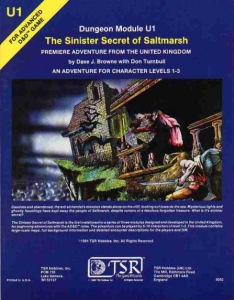
The Sinister Secret of Saltmarsh is a module for the Advanced Dungeons & Dragons (AD&D) roleplaying game, written by Dave J. Browne with Don Turnbull. The module details a mysterious abandoned mansion at the edge of a town called Saltmarsh, and the secrets contained therein. The adventure is set in the World of Greyhawk campaign setting. The Sinister Secret of Saltmarsh received positive reviews from critics.
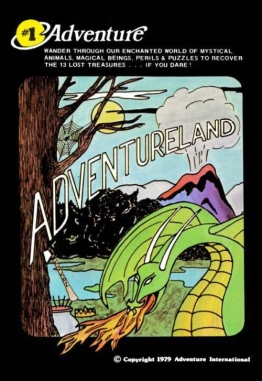
Adventureland is a text adventure video game for microcomputers, released by Scott Adams in 1978. The game has no plot but simply involves searching for thirteen lost artifacts in a fantasy setting. Its success led Adams to form Adventure International, which went on to publish thirteen similar games in the Adventure series, each in different settings.

Pirate Adventure is a text adventure video game written by Scott Adams. It was published by Adam's company, Adventure International, in 1979.
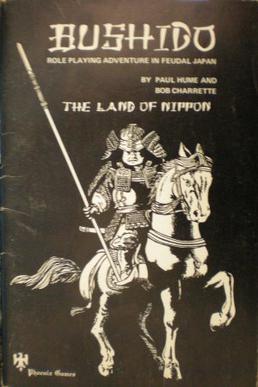
Bushido is a Samurai role-playing game set in Feudal Japan, originally designed by Robert N. Charrette and Paul R. Hume and published originally by Tyr Games, then Phoenix Games, and subsequently by Fantasy Games Unlimited. The setting for the game is a land called Nippon, and characters adventure in this heroic, mythic, and fantastic analogue of Japan's past.

Android Nim is a computerized version of the strategy game Nim programmed by Leo Christopherson for the TRS-80 and published in 1978 by 80-NW Publishing. A port to the Commodore PET by Don Dennis was released in July 1979, followed by an Apple II version in 1980.

Ghost of Lion Castle is a 1984 adventure module for the Dungeons & Dragons fantasy roleplaying game. Its module code is BSOLO, and it was written by Merle M. Rasmussen with cover art by Bob Maurus.

Strange Odyssey is a text adventure written by Scott Adams and Neil Broome.
Adventure International was an American video game publishing company that existed from 1979 until 1986. It was started by Scott and Alexis Adams. Their games were notable for being the first implementation of the adventure genre to run on a microcomputer system. The adventure game concept originally came from Colossal Cave Adventure which ran strictly on large mainframe systems at the time.

The Dungeons & Dragons Basic Set is a set of rulebooks for the Dungeons & Dragons (D&D) fantasy role-playing game. First published in 1977, it saw a handful of revisions and reprintings. The first edition was written by J. Eric Holmes based on Gary Gygax and Dave Arneson's original work. Later editions were edited by Tom Moldvay, Frank Mentzer, Troy Denning, and Doug Stewart.
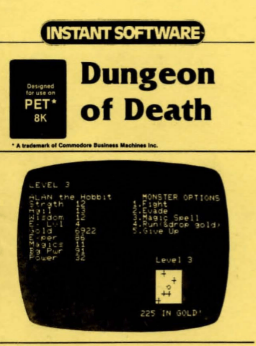
Dungeon of Death is a fantasy role-playing video game developed by Instant Software. The game was released on the 8K Commodore PET.

Time Traveler is a 1980 fantasy text adventure developed by Krell Software. The game was released on the 16K, Level II TRS-80, Apple II, Commodore PET, and Atari 8-bit computers

Neverwinter Nights is a series of video games developed by BioWare and Obsidian Entertainment, based on the Forgotten Realms campaign setting of the Dungeons & Dragons role-playing game. Aside from also being set around the city Neverwinter, it is unrelated to both the 1991 Neverwinter Nights online game and the 2013 online game called Neverwinter.
Space Games-3 is a 1980 video game by Creative Computing for the TRS-80 Model I Level II.

Tyler Christopher Herro is an American professional basketball player for the Miami Heat of the National Basketball Association (NBA). He played college basketball for one year with the Kentucky Wildcats.

















